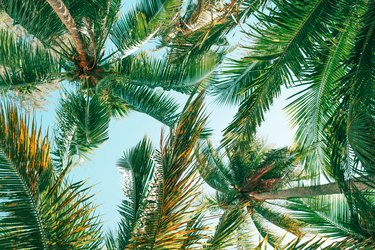
Unlike most other species of broadleaved trees, which grow a few large roots that spread deeply and grow in diameter, palm tree roots emerge from a small area called the root-initiation zone. Though these tiny roots are numerous, they do not increase in diameter and generally spread outward within the top few feet of soil. Though a few palms have deeper, more invasive roots, many species produce shallow, non-invasive root systems. Palms are classified as feather or fan, depending on their foliage.
Palm Trees With Non-invasive Roots
Video of the Day
Feather palms have pinnate foliage with a feathery appearance. Non-invasive species include the coconut palm (Cocos nucifera, USDA zones 10-12), a native of the tropics that grows to 65 feet tall. Coconut palms have stiff, spreading fronds and thrive in sunny, sandy sites.
Video of the Day
The Carpentaria palm (Carpentaria acuminata, zones 10-11) grows to 50 feet tall and has a straight, single trunk and stiff, dark-green fronds. It prefers full sun exposures and well-draining soil. Other tall, non-invasive species include the Canton fishtail palm (Caryota ochlandra, zones 10-11).
Small Feather Palm Trees
Smaller, non-invasive feather palms include the pygmy date palm (Phoenix roebelenii, zones 10-11), a slow-growing dwarf palm that reaches 8 feet. These spiny trees have arching, gray-green foliage and grow best with regular irrigation in sun to partial shade.
Pindo palms (Butia capitata, zones 8-10) grow up to 20 feet tall and have inward-curving, gray-green fronds. They have thick trunks and produce edible fruits. Pindo palms prefer partial or light shade and grow slowly. Other small, non-invasive species include the clustered fishtail palm (Caryota mitis, zones 9-10) and the MacArthur palm (Ptychosperma macarthuri, zones 10-11).
Large Fan Palms
Fan palms have palmate foliage that often resembles folded paper fans. These palms grow in a range of sizes and forms. For example, the Mexican fan palm (Washingtonia robusta, zones 9-11) can quickly grow from 40 to 100 feet tall. This straight-trunked tree has bright-green foliage that spreads in a 10- to 15-foot-wide canopy. The Mexican fan palm root system is non-invasive, transplants easily and grows well in full sun to partial shade.
The bismark palm (Bismarckia nobilis, zones 9-12) grows to 70 feet tall and has stiff, blue-green fronds that grow in windmill formations around its single trunk. It prefers sunny sites with acidic soil.
Two palms in the Brahea genus have low root damage potential. These include the Mexican blue (Brahea armata, zones 8-11), which grows to 50 feet with spiny, silver-gray foliage, and the 35-foot-tall Guadalupe (Brahea edulis, zones 10-11) which has stiff, light-green fronds. Both thrive in sunny sites and tolerate drought.
Small Fan Palms
Smaller, non-invasive root trees with fan foliage include the Mediterranean fan palm (Chamaerops humilis, zones 8-11), which grows from 5 to 20 feet. A slow-growing, cold-hardy tree, this fan palm has multiple trunks and blue- to gray-green, stiff fronds. It grows best with regular irrigation and tolerates sunny to partially shady exposures.
The Chinese fan palm (Livistona chinensis, zones 9-11) grows from 15 to 25 feet tall and has glossy, light-green foliage that forms a drooping crown. It grows best in partially shaded sites with regular irrigation. Other small, non-invasive fan palms include the rattan (Rhapis humilis, zones 9-11) and the Florida silver palm (Coccothrinax argentata, zones 10-11).